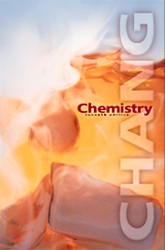|
 |  Chemistry, 7/e Raymond Chang,
Williams College
Visual Chemistry Lets start by visiting the Okanagan University site at http://www.sci.ouc.bc.ca/chem/molecule/molecule.html.
Go to the index of models and click on amides. When that link appears go to number
7, ethanamide, or acetamide, as it is more usually called. Now click on this molecule
and you should soon see a wireframe view of it. Click and hold to see other display
options (this will vary depending on browser and plug-in). Go to ball and stick
and display the molecule in the way that most chemists think about molecules.
Notice that you can rotate the molecule by clicking and quickly dragging the cursor.
The colors of the atoms are important because they tell you what atoms are present.
Generally, gray represents carbon, white represents hydrogen, blue is nitrogen,
red is oxygen, and green is chlorine.
- Using the colors of the atoms, write the molecular formula of this molecule.
- Notice that while the
carbon of the CH3 group has four atoms attached to it, the other
carbon does not. Can you explain the bonding at this carbon? To be sure that
you understand the electronic structure of this molecule write the electron-dot
formula for it.
- Look carefully at the five atoms--H2NCO. How would you describe
the geometry of these five atoms? What do the angles between the bonds seem
to be?
- Now, go back to the index, select amines, and click on number 21, ethanamine,
usually called ethyl amine. Examine the groups around the nitrogen in this
molecule. How would you discribe the difference between the geometry at this
site compared with the nitrogen in acetamide?
- With ethyl amine in front of you, change the display mode to space-fill
using van der Waals radii. Then return to ball and stick display and use the
option menu to go to dot surface using van der Waals radii. What do you suppose
the space-filling and dot surface models are meant to represent?
- Now go to the molecular viewing gallery at http://www.dcu.ie/%7Echemist/pratt/pdb/gallery.htm:
- Examine adamantane and determine its molecular formula, its empirical formula,
and draw a line formula for it.
- Look at boron trfluoride and determine the geometry of this molecule.
- A plane of symmetry is a hypothetical plane that can be drawn through a
molecule such that the parts of the molecule on both sides of the plane are
mirror images of one another. For example, in BF3, there is a plane
perpendicular to the plane of the molecule passing through one fluorine and
the boron. On one side of this plane there is a fluorine. Imagine that the
plane is a mirror. When you look into the mirror from the side of this fluorine
the image that you see is exactly what the fluorine on the other side of plane
looks like. How many planes of symmetry are there in the molecule?
- Now examine the boron trifluoride-ammonia complex. Have the bond angles
around the boron changed relative to those in boron trifluoride?
- Examine bicyclo[2,2,2]octane. How many six membered rings are there in this
molecule? How many planes of symmetry can you find in this molecule?
- Take a close look at Z-but-2-ene and E-but-2-ene. Write the structural formula
for each molecule. Are these really different molecules? Do these two compounds
have different boiling points, different refractive indices, etc.?
- Now look at butane (staggered), butane (ecclipsed), and butane (gauche).
Write the structural formula for each of these molecules. Are these different
molecules? How do these molecules differ from one another? What is ecclipsed
in the ecclipsed molecule?
- What are the bond angles at each of the carbons in cyclohexanone? To what
hybridization do these angles correspond? Can you find a plane of symmetry
in this molecule?
- Cubane was first prepared about 30 years ago after chemists had tried for
many years to prepare it. What are the bond angles at each carbon? What were
the bond angles in the other hydrocarbons you have examined? Why might cubane
be difficult to prepare?
- Look at iso-butyl propionate and n-butyl propionate. What is the difference
between the two molecules? Can you find another ester [the functional group
in these molecules is the ester group] that also contains an iso group?
- Take a look at t-butyl acetate and compare it with the two esters in part
10. What is the difference between these three butyl groups?
- Write the molecular formula for naphthalene. How would you describe the
geometry of this molecule? How many planes of symmetry can you locate?
- How would you describe the geometry of phosphorus pentachloride? If one
of the chlorines were replace by a bromine, how many different molecules would
there be?
- Do any of the atoms in pyridine have a lone pair of electrons? Molecules
that can donate a pair of electrons are said to be Lewis bases or nucleophiles;
molecules that can accept a pair of electrons are Lewis acids or electrophiles.
Is pyridine a Lewis acid or a Lewis base?
- Molecules that have a hydrogen attached to oxygen or nitrogen or fluorine
usually have fairly strong forces between them. These forces are called hydrogen-bonding.
The hydrogen of one molecule acts as a Lewis acid or electrophile toward a
neighboring molecule, which donates electron density (acts as a nucleophile)
from a lone pair to the hydrogen. Does salicylic acid exhibit hydrogen bonding?
Can you find the nucleophilic sites on the salicylic acid?
|
|
|



 2002 McGraw-Hill Higher Education
2002 McGraw-Hill Higher Education

 2002 McGraw-Hill Higher Education
2002 McGraw-Hill Higher Education